Don’t Let Your Frog Eat Your Fish: 5 Possible Tank Mates for African Clawed Frogs
When you purchase through links on our site, we may earn a commission. Here’s how it works.
Thinking of adding some African clawed frog tank mates? Be careful—too many hobbyists make a fatal mistake: treating clawed frogs like peaceful dwarf frogs. In reality, one wrong tank mate can mean injury, stress, or even death for your frogs or fish.
African clawed frogs (ACFs) are fascinating amphibians with unique behaviors, but keeping them in a community tank requires careful planning and consideration. Too often, hobbyists assume these frogs are compatible with small, peaceful fish. In reality, ACFs are opportunistic predators that can and will eat anything that fits in their mouths, including expensive or beloved fish.
Table of Contents
In this guide, we’ll cover the essentials: which tank mates are truly safe, how to set up your tank for minimal conflict, and common myths to avoid. Let’s build a thriving mixed tank — without the casualties.
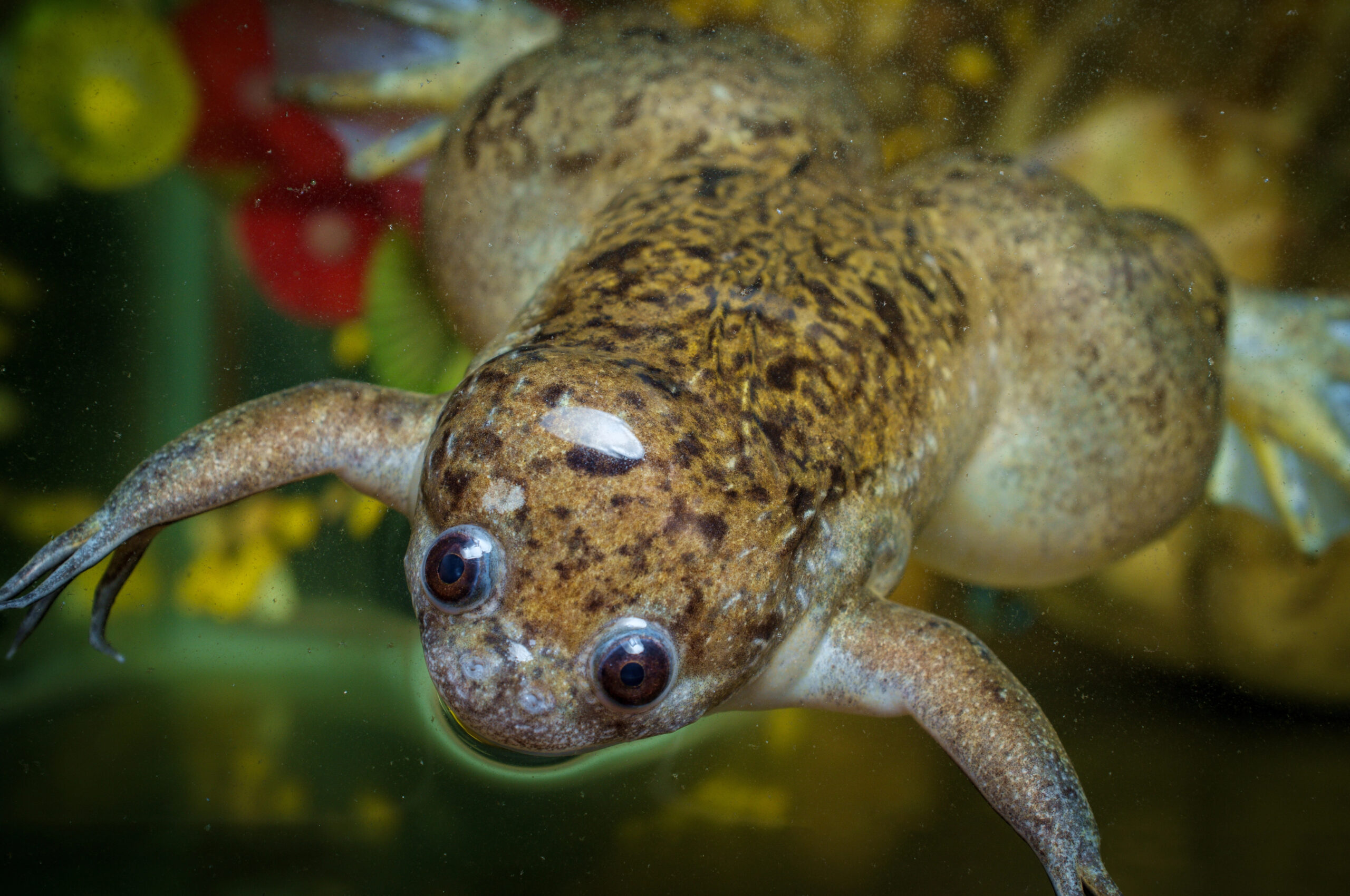
Get to Know the African Clawed Frog (ACF)
Before adding any tank mates, it’s crucial to fully understand the species you’re working with. The African clawed frog (Xenopus laevis) is not your average community amphibian. Native to sub-Saharan Africa, these fully aquatic frogs are resilient, adaptable, and long-lived—but they have very specific care needs.
Basic Profile:
- Scientific Name: Xenopus laevis
- Common Names: African clawed frog, ACF, Xenopus
- Lifespan: 10–20 years with proper care
- Adult Size: 4–6 inches (females often larger than males)
- Color Variants: Wild-type (olive/gray), Albino (common in the pet trade), and leucistic
- Habitat: Fully aquatic, bottom-dwelling, but will surface to breathe
- Native Range: Sub-Saharan Africa (slow-moving rivers, ponds, marshes)
Key Characteristics:
- Clawed toes: The species is named for the three black claws on its hind feet, used for tearing apart food.
- No tongue or teeth: ACFs use their front limbs to shovel food into their mouths.
- Sensitive skin: Easily damaged by sharp substrate or aggressive tank mates.
- Highly opportunistic: Will eat anything it can catch—live, dead, moving, or still.
Behavior and Temperament:
- Not aggressive toward larger animals, but extremely predatory toward smaller ones.
- Nocturnal hunters: Most active at night, especially during feeding.
- Clumsy swimmers: Can knock over decorations or disturb tank mates.
- Messy eaters: Produce a lot of waste, requiring solid filtration.
Common Misconceptions:
- They are not dwarf frogs: African Dwarf Frogs (ADFs) are a different genus, much smaller, and community-friendly.
- They do not do well with small fish: Even if coexistence seems peaceful at first, small fish often vanish overnight.
- They require more space than most expect: a minimum of 20 gallons for one adult; cramped tanks lead to stress and illness.
Understanding the nature of African clawed frogs helps avoid tragic mistakes and sets the foundation for responsible, ethical amphibian care.
Quick Check: Which Frog Do You Have?
One of the most common and costly mistakes in amphibian care is misidentifying your frog. Many pet stores—and even online sellers—mislabel frogs, leading hobbyists to confuse the African clawed frog (ACF) with the African dwarf frog (ADF). These species have very different care needs, behaviors, and compatibility requirements.
Here’s a quick side-by-side comparison to help you determine which frog you actually have:
| Eyes on the sides of the head | African Clawed Frog (ACF) | African Dwarf Frog (ADF) |
|---|---|---|
| Scientific Name | Xenopus laevis | Hymenochirus spp. |
| Adult Size | 4–6 inches | 1.5–2 inches |
| Body Shape | Stocky, muscular body | Slimmer, more delicate build |
| Feet | Hind legs have three black claws | Fully webbed feet, no claws |
| Eyes | Eyes on top of the head | Eyes on the sides of the head |
| Skin Texture | Smooth and rubbery | Mottled or spotted appearance |
| Behavior | Predatory, may eat fish | Peaceful, safe with small fish |
| Common Color | Albino or olive-gray | Brown or gray with speckles |
| Tank Size Needed | 20+ gallons | 10+ gallons |
If your frog has claws on its hind feet and a chunky build, you likely have an African clawed frog, pictured below.
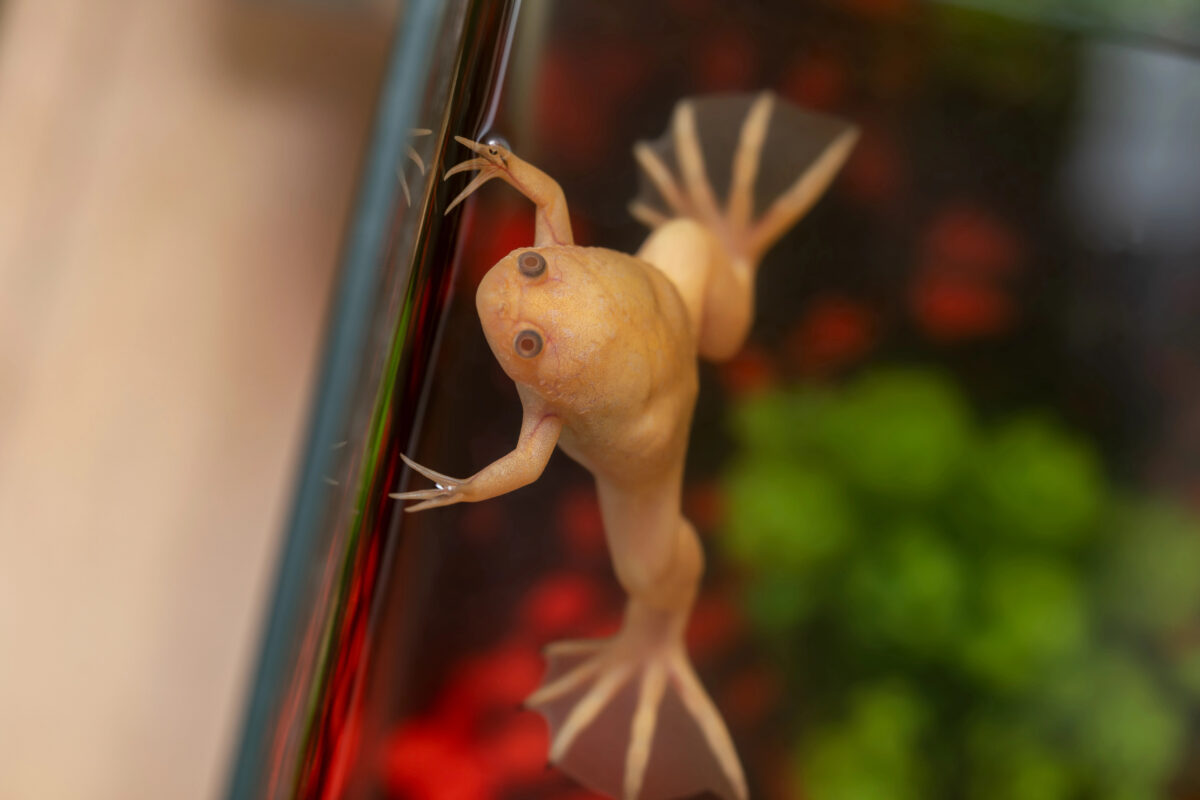
If your frog is small, has fully webbed feet and no claws, you likely have an African dwarf frog, pictured below.
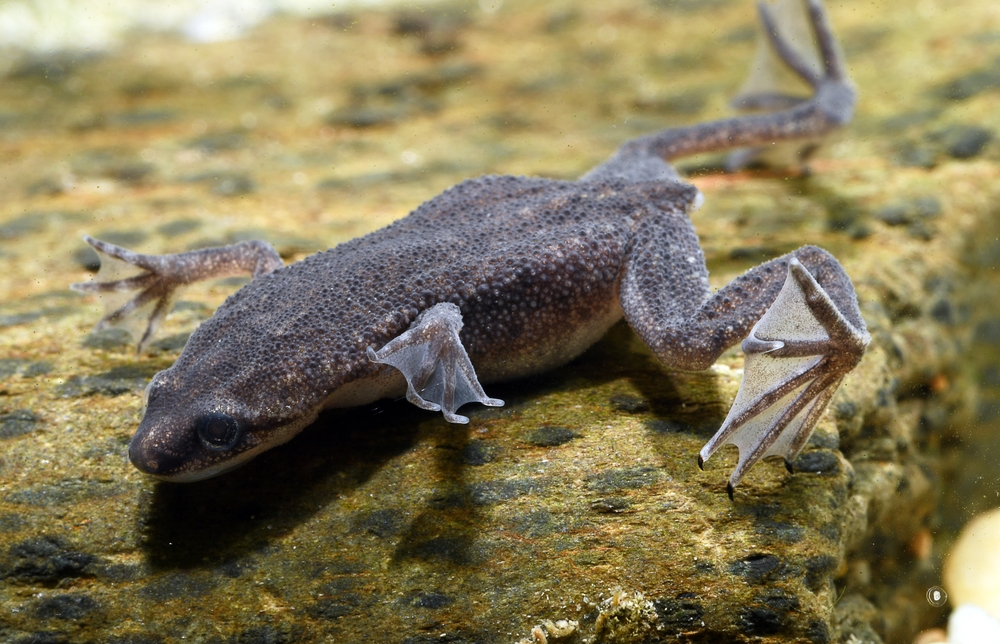
Make sure you’re using the right care guide for your species—what works for a dwarf frog may be dangerous or even fatal for a clawed frog (and vice versa).
6 Key Compatibility Factors
When selecting tank mates for ACFs, consider these variables:
- Tank Size: Minimum 20 gallons for one frog; add 10 gallons for each additional frog or group.
- Size: Any fish or invertebrate must be too large to fit in the frog’s mouth.
- Behavior: Avoid fast, nippy fish that may harass the frog.
- Feeding: ACFs are messy and aggressive feeders; tank mates must be able to compete without stress.
- Tank Zone: Mid- and upper-swimming fish are safer than bottom dwellers.
- Temperature: Ideal range is 70°F to 78°F (21–26°C).
8 Common Mistakes to Avoid
Even well-intentioned hobbyists can run into trouble when keeping African clawed frogs—especially in community tanks. Whether it’s rushing the setup, misjudging compatibility, or skipping key steps in care, these common mistakes can lead to stress, injury, or even fatal outcomes. Knowing what to avoid is just as important as knowing what to do right.
- Misidentifying your frog: Many owners confuse African clawed frogs with African Dwarf Frogs, leading to incompatible tank setups and feeding plans.
- Adding small or slow fish: If it fits in the frog’s mouth, it will likely be eaten. “Test” fish rarely last long.
- Skipping quarantine: New fish or frogs can introduce parasites or stress—always isolate newcomers first.
- Overstocking the tank: ACFs are messy and produce a high bioload. Too many tank mates quickly overwhelm your system.
- Underestimating feeding aggression: ACFs are ambush predators and will snap at moving tank mates during feeding.
- Mixing incompatible water parameters: Some fish need warmer or softer water than ACFs prefer. Mismatched needs lead to long-term stress.
- Using sharp or loose substrate: Frogs dig and scoot along the bottom—gravel can injure their skin or trap uneaten food.
- Assuming compatibility equals success: Just because a species has worked for others doesn’t mean it will in your tank. Observation and flexibility matter most.
These mistakes are common for a reason—even experienced aquarists make them. The good news is that with the right planning, observation, and a little patience, they’re all avoidable. Take your time, stay flexible, and always put the safety of your frog (and its tank mates) first.
5 Conditionally Compatible African Clawed Frog Tank Mates
While African clawed frogs are generally best kept alone, a small number of carefully selected species may coexist under the right conditions. These tank mates are not truly “safe”—they’re conditionally compatible and should only be introduced with caution, close observation, and a backup plan. Every frog is different, and what works in one tank may fail in another.
Below are five species that have shown some success in mixed setups with ACFs, but proceed at your own risk—and always prioritize the health of all animals involved.
1. Large, Hardy Snails
Mystery snails and apple snails can coexist with ACFs due to their size and tough shells. They contribute to tank cleanliness by grazing on algae. However, curious frogs might nip or flip them, especially near the surface. You must maintain a calcium-rich water supply for shell health, and ensure the tank has a secure lid to prevent escapes.
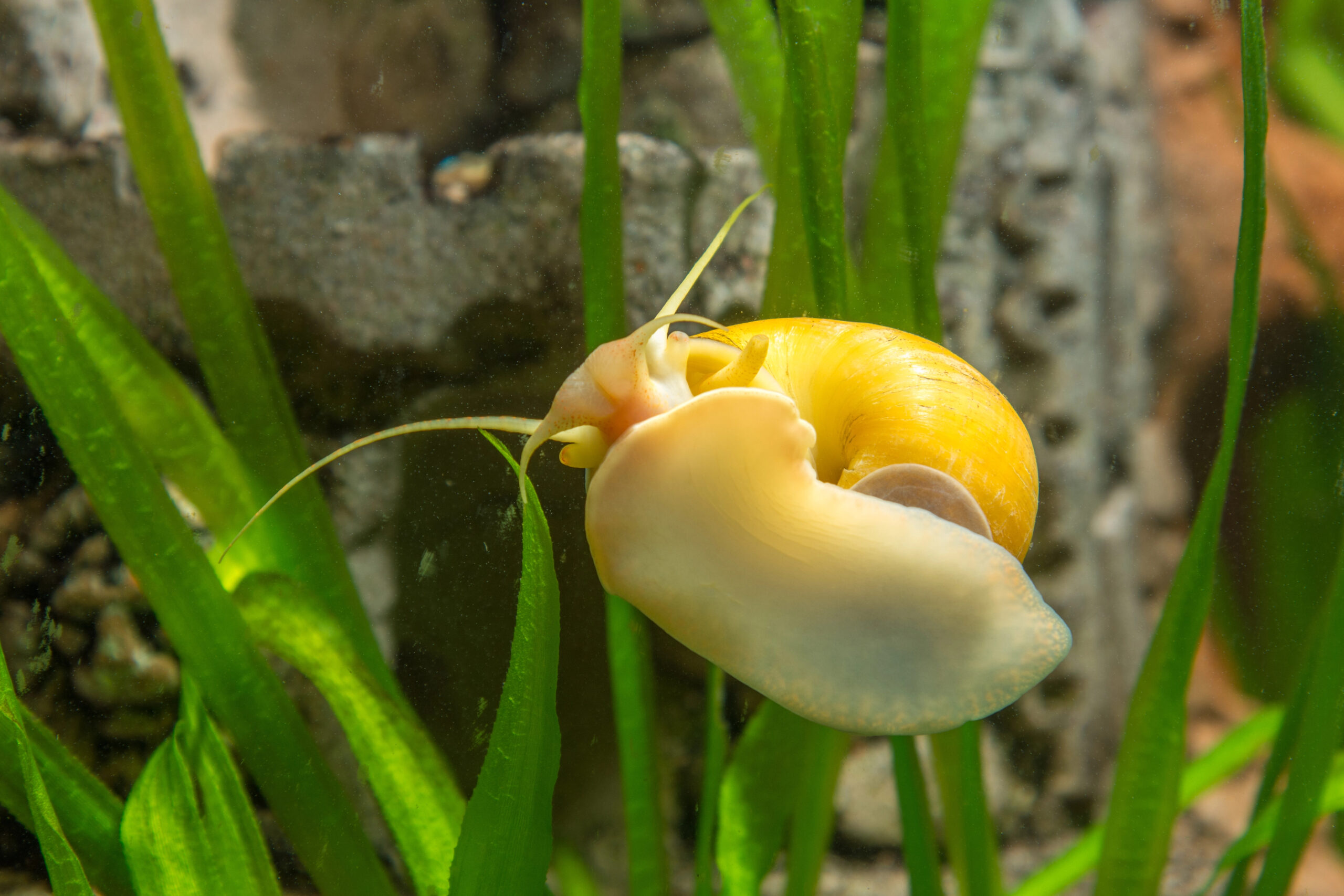
- Examples: Mystery Snails (Pomacea bridgesii), Apple Snails (Pomacea canaliculata)
- Size: 2–3 inches
- Pros: Too large to eat, peaceful, helpful algae grazers
- Cons: May be harassed or flipped; vulnerable near the surface
- Risk Factor: May be nipped, flipped, or disturbed when climbing above the waterline.
- Caution: Ensure snails are large enough and monitor for signs of shell damage.
Beginner-Friendly: Low risk if large enough; may be flipped or pestered, but rarely injured. Monitor for shell damage or persistent frog interest.
2. Bristlenose Pleco (Ancistrus spp.)
Bristlenose plecos are popular bottom-dwelling algae eaters with armor-like scales that deter frog curiosity. They generally ignore frogs and prefer to hide during the day. Make sure to provide driftwood and hiding spots, and avoid introducing small juveniles that may be mistaken for food.
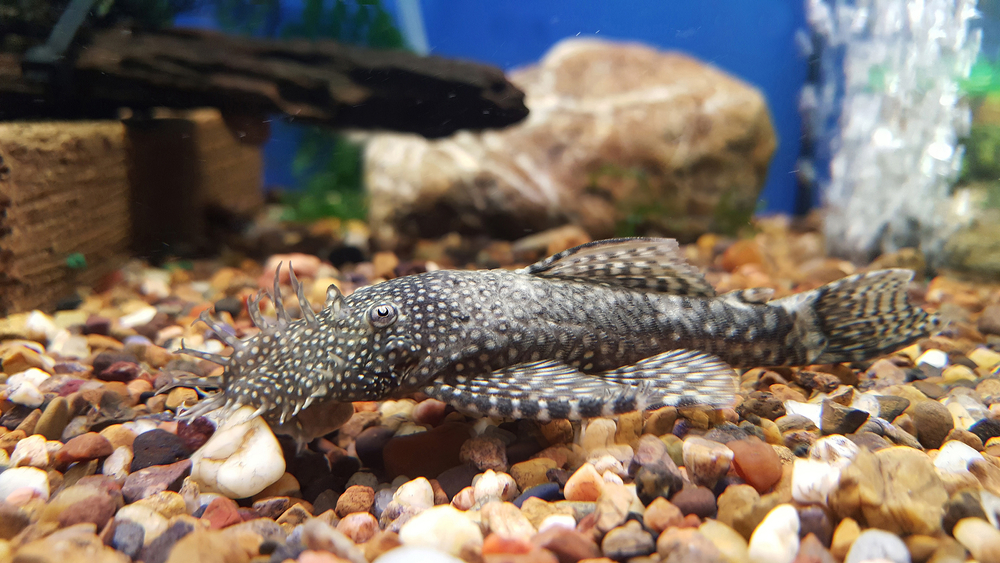
- Size: 4–5 inches as adults
- Pros: Armored body, low aggression, great algae eater
- Cons: Juveniles under 2.5 inches may be at risk
- Risk Factor: Small juveniles may be attacked or eaten.
- Caution: Introduce only when pleco is >3 inches and ensure hiding places are available.
Intermediate Keepers: Best introduced once fully grown; juveniles may be attacked. Needs hiding spaces and a driftwood-rich environment.
3. Rosy Barbs (Pethia conchonius)
Rosy barbs are fast and robust enough to evade interactions with frogs. They stay mostly in the upper water column, reducing the chance of conflict. For best results, maintain them in schools of at least five, in a well-oxygenated and spacious tank of 40+ gallons. Avoid long-finned varieties, as frogs may nip at flowing fins.
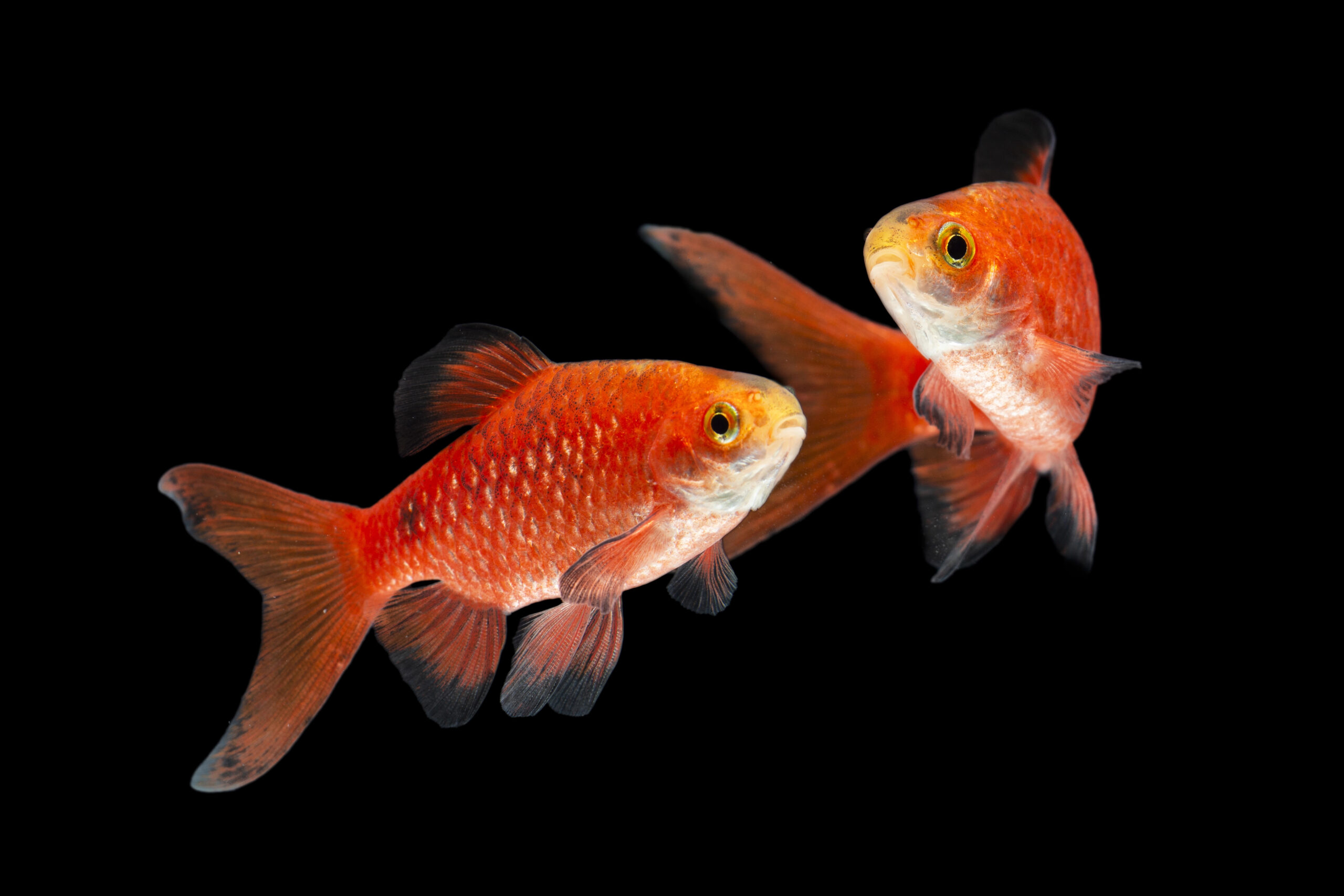
- Size: 2.5–3 inches
- Pros: Active, upper-level swimmers, less contact with frogs
- Cons: Need to be kept in groups of 5+; require oxygen-rich tanks
- Risk Factor: Fin-nipping if under-stimulated; risk of stress if overcrowded.
- Caution: Keep in groups of 5 or more and avoid long-finned varieties.
Intermediate Keepers: Fast swimmers with potential to outcompete frogs for food. Best kept in groups and in well-decorated tanks with ample cover.
4. Zebra Danios (Danio rerio)
Zebra danios are quick and tend to avoid the bottom zones where ACFs lurk. Their speed is their best defense, although their small size can still make them vulnerable. Keep them in schools of 6 or more with open swimming areas and floating plants for cover. Only attempt in well-established, large tanks.
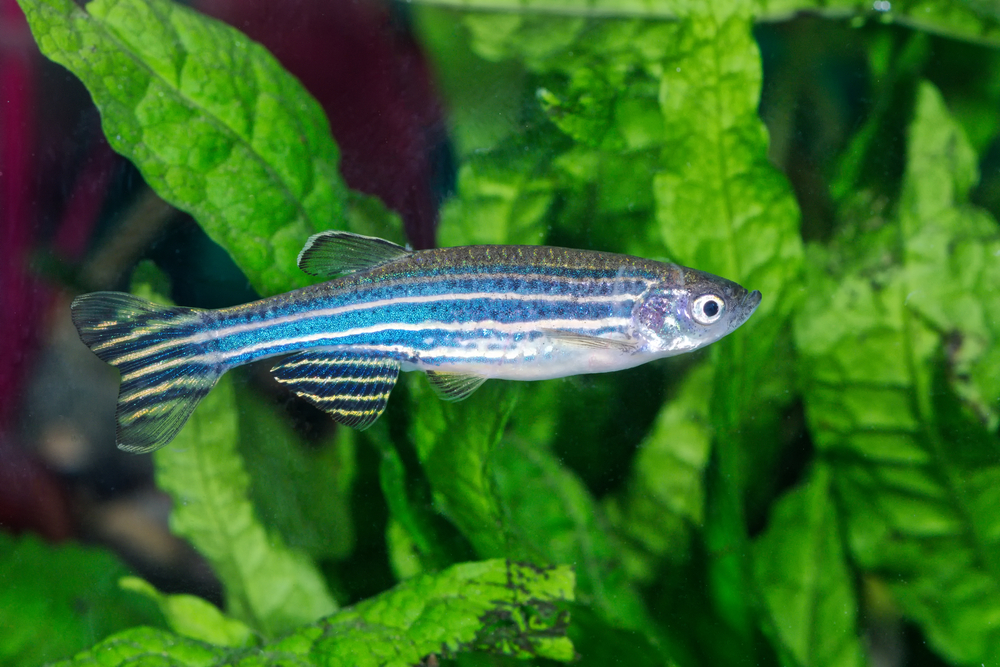
- Size: ~2 inches
- Pros: Fast swimmers, upper-tank dwellers
- Cons: Small size still carries the risk of predation
- Risk Factor: Small size can still make them vulnerable, especially to larger female frogs.
- Caution: Only keep in groups and in heavily planted tanks with upper swimming zones.
Intermediate Keepers: May trigger the frog’s prey drive if too small. Works best in larger tanks with dense plants and upper water column activity.
5. Golden Dojo Loach (Misgurnus anguillicaudatus)
Golden dojo loaches are curious, gentle bottom dwellers that can grow too large to be eaten. They’re quirky and often burrow or wriggle along the substrate, making them fun to observe. However, they thrive in slightly cooler water, so only attempt cohabitation if your tank’s range allows overlap around 72–75°F.
- Size: 6–8 inches
- Pros: Too large to be eaten, peaceful temperament
- Cons: Prefers cooler water; may not match ACF temp range
- Risk Factor: Temperature mismatch; may be sluggish or stressed in warmer ACF tanks.
- Caution: Use only in cooler ACF tanks (~72–75°F) with sand substrate.
Intermediate to Advanced: Peaceful but sensitive to warmer ACF tanks. Avoid sharp substrates and provide a cooler temperature range if possible.
Bonus: Rubber Lip Pleco (Chaetostoma formosae)
Rubber lip plecos are smaller than bristlenose but still armored and peaceful. They require well-aerated tanks with good flow and are best suited to mature aquariums. Though generally ignored by ACFs, avoid adding undersized individuals that could be viewed as prey.
- Size: 3.5–4 inches
- Pros: Peaceful, armored, excellent algae control
- Cons: Sensitive to oxygen levels and water quality
- Risk Factor: Sensitive to water quality and low oxygen.
- Caution: Avoid tanks with poor water flow; they require high oxygen levels and a supplemental diet.
While not a top-tier candidate, the Rubber Lip Pleco may be suitable in certain well-managed ACF setups—provided water quality, temperature, and oxygen requirements are closely monitored.
Advanced Only: Highly oxygen-sensitive and requires pristine water. May starve without supplemental feeding and can become stressed in messy tanks.
When in doubt, remember: If it fits in a frog’s mouth, it will likely end up there.
Trial Period & Observation Tips
Always monitor closely for signs of stress, missing tank mates, or aggression. Introduce new species one at a time, and observe behavior over several days. Keep a backup tank or divider on hand in case separation becomes necessary.
- Introduce only one species at a time — preferably in a fully cycled, stable environment.
- Use a tank divider for the first 48–72 hours, if possible, to gauge visual interaction.
- Feed both species separately, staggering their feeding times to avoid competition or aggression.
- Observe for signs of:
- Missing or injured tank mates
- Food competition or refusal to eat
- Hiding, lethargy, or visible wounds
- Perform water tests regularly — ACFs are messy, and adding tank mates increases bioload.
If Things Go Wrong
- Have a backup tank or quarantine setup (5–10 gallons with a heater and sponge filter).
- Immediately remove injured or stressed tank mates to prevent further harm.
- Use a breeding box or tank divider for temporary separation if no spare tank is available.
- Reevaluate tank size, feeding strategy, and compatibility before reintroducing the fish.
Unsafe African Clawed Frog Tank Mate Categories
Not all tank mates are suitable for African clawed frogs. Many species are simply too small, too aggressive, or too fragile to survive in the same environment.
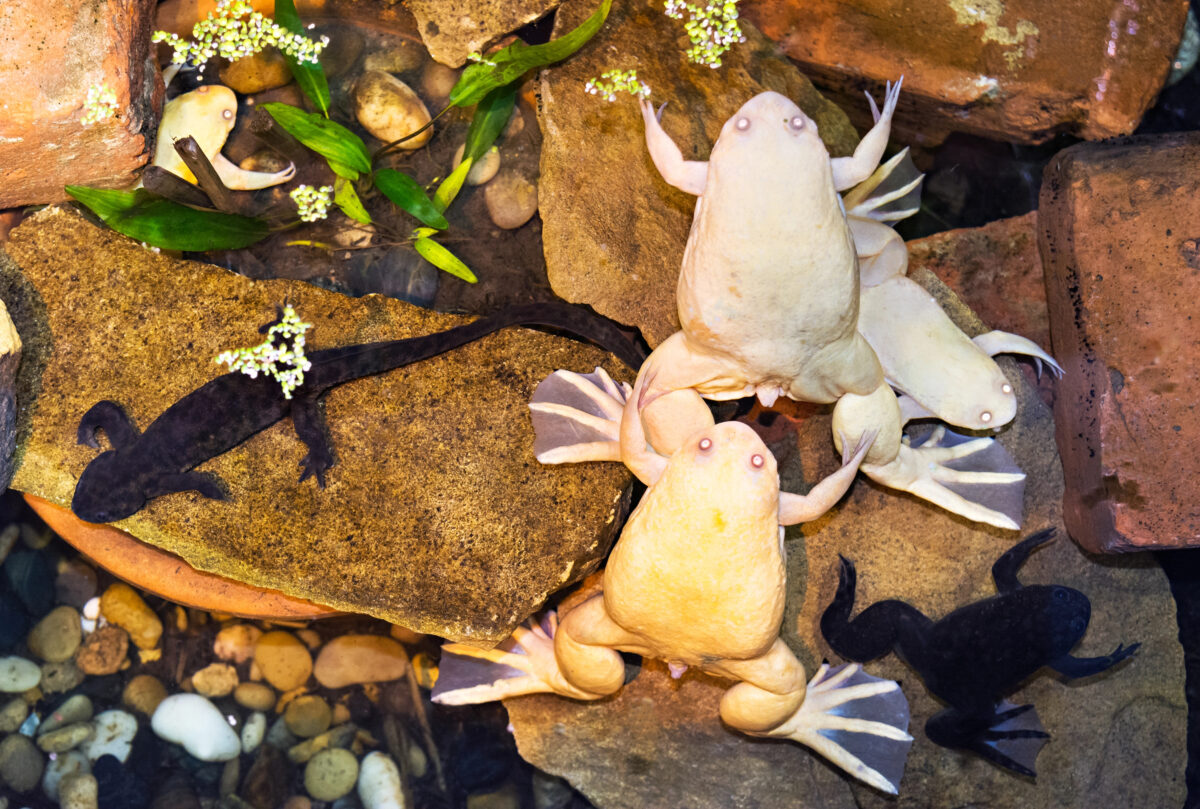
Here’s a breakdown of categories and why you should avoid them:
1. Small Schooling Fish
Fish such as guppies, neon tetras, ember tetras, and endlers may seem like peaceful additions to a tank, but they are highly vulnerable. ACFs are opportunistic and will consume these fish without hesitation, often at night when the frogs are most active. Even if these fish appear to coexist for a few days, they will likely disappear one by one.
2. Shrimp and Dwarf Snails
Invertebrates like cherry shrimp, ghost shrimp, Amano shrimp, and small nerite or ramshorn snails are all considered food by ACFs. These amphibians have poor eyesight but excellent sensory perception, and anything moving slowly near the bottom is fair game. These species offer no defense and are often eaten quickly.
3. Small or Passive Bottom Dwellers
Species like Corydoras catfish, Kuhli loaches, and Otocinclus catfish are slow, peaceful, and dwell in the same zone as ACFs. This puts them at high risk for nipping, bullying, or predation. Additionally, frogs may compete with these species for food and territory, leading to stress or starvation for the fish.
4. Aggressive or Nippy Fish
Certain species, like tiger barbs, African cichlids, bettas, and gouramis, are known for territorial or aggressive behavior. These fish may bite at the frog’s sensitive skin, toes, or eyes, causing infections, injuries, or even death. ACFs have few means of defense and do not do well when harassed or stressed by tank mates.
5. Delicate or Fin-Nipping Targets
Fancy goldfish, angelfish, and long-finned tetras should be avoided. Fancy goldfish require cooler temperatures and produce excessive waste, while long-finned species often fall victim to frog curiosity or accidental biting. These combinations often result in stress and shortened lifespans for both species.
6. Very Small Juveniles or Fry
Even species considered safe when full-grown may be risky if introduced while young. Juvenile plecos, barbs, or loaches under 2 inches may be viewed as prey by an adult ACF. Always ensure tank mates are introduced at a size that clearly exceeds the frog’s gape width.
When choosing tank mates, always ask yourself: “Could my frog reasonably eat, harass, or be injured by this animal?” If the answer is yes, the pairing is unsafe.
While some tank mates may survive with African clawed frogs under ideal conditions, a species-only tank remains the safest and most successful long-term option for most hobbyists. It minimizes stress, eliminates compatibility risks, and allows you to focus entirely on the specific needs of your frogs. If you’re ever in doubt, choosing not to mix is often the most responsible—and rewarding—choice.
Caring for African Clawed Frogs
Even without tank mates, African clawed frogs require specific care to remain healthy and stress-free. They are hardy but messy, curious but easily stressed by change, and long-lived when kept in stable conditions.
Water Quality & Parameters
- Temperature: 70–78°F (21–26°C) – use a heater for consistency
- pH: 6.5–7.8 – keep stable
- Ammonia/Nitrites: Always 0 ppm; Nitrates < 40 ppm
- Filtration: Gentle sponge or canister filter; avoid strong currents
- Water Changes: 25–50% weekly with dechlorinated water
Diet & Feeding
- Feed 3–4 times per week (adults); more often for juveniles
- Use sinking frog pellets, earthworms, bloodworms, and brine shrimp
- Feed at night with tongs for the best results and reduced mess
Behavior & Enrichment
- Low or diffuse lighting; avoid harsh lights
- Decor: Smooth rocks, PVC pipes, driftwood, floating plants
- Secure, escape-proof lid is essential – frogs can jump!
Health Watchlist
- Red limbs, bloating, cloudy eyes, and lethargy are red flags
- Quarantine new arrivals for 2 weeks minimum
- Avoid copper-based medications
As highlighted in our Betta and Dwarf Frog compatibility and frog diet guides, many aquatic frogs, including African clawed frogs, are opportunistic feeders that will consume anything small, slow, or soft-bodied enough to catch. Their lack of social awareness or hesitation means peaceful fish or shrimp can quickly become food. This reinforces the importance of tank mate size, speed, and separation during feeding.
Caring for Fish and Other Tank Mates
Adding tank mates requires balancing the needs of multiple species. What benefits the frog may stress the fish, and vice versa. Careful planning and ongoing observation are key.

Water Harmony
- Match species that tolerate 70–78°F and similar pH (6.5–7.5)
- Avoid species needing rapid flow, cooler water, or specialty pH
- Use sponge pre-filters to protect small fish and reduce stress
Feeding Protocol
- Feed tank mates during the day with floating/midwater food
- Feed ACFs at night with tongs near their hideouts
- Remove leftovers quickly to prevent spikes in ammonia
- Supplement algae eaters with blanched veggies or wafers
Behavioral Balance
- Choose fish that use different zones (mid/top water)
- Add hiding spots and sight breaks with rocks/plants
- Watch for hiding, fin damage, or erratic swimming
Backup Plan
- Keep a backup 5–10 gallon tank ready for emergencies
- Monitor new tank mates daily for 2 weeks
- Remove any fish showing stress, aggression, or injury
Ultimately, caring for fish and other tank mates in an African clawed frog setup is about balancing needs, not forcing compatibility. Every species you introduce adds complexity, and no tank mate is ever guaranteed to work long-term.
By staying proactive with water quality, feeding routines, and behavior monitoring, you give all inhabitants the best chance at peaceful cohabitation. But always be prepared to separate animals at the first sign of stress or injury, because when it comes to mixed-species tanks, flexibility is just as important as planning.
Know the Risks, Respect the Frog
African clawed frogs are fascinating, intelligent, and rewarding amphibians—but they’re not easy-going roommates. While a handful of tank mates can coexist under the right conditions, the risks are real and the margin for error is small.
If you’re new to amphibian care, the safest and most ethical approach is to give your ACF a species-only setup with plenty of space, clean water, and thoughtful enrichment. For experienced keepers ready to try a mixed tank, success depends on careful planning, ongoing observation, and a willingness to separate species if needed.
Remember: just because a tank mate can work doesn’t mean it will in your specific setup. Every frog is different—and their instincts always come first.
Start with caution. Monitor constantly. And always have a backup plan. If you’re ever unsure, choose safety over experimentation. Your frog (and your fish) will thank you.
Comparing Tank Mate Risks: From Cichlids to Clawed Frogs
Tank mate compatibility isn’t just a challenge with frogs; it’s a recurring theme across many aggressive, territorial, or predatory species. For example, Flowerhorn cichlids are notoriously combative, requiring tank mates that can withstand bullying or be separated entirely. Crayfish pose a different risk: they’re slow but armed with claws, making them dangerous to anything that lingers near the bottom. Even peaceful species like German Blue Rams and Peacock Cichlids demand exacting water conditions and social balance to prevent stress and aggression.
The takeaway? Every species brings its own limitations to a mixed tank—and African clawed frogs are no exception. Their tendency to eat anything that fits in their mouth, combined with a lack of social cues or warning signs, makes them especially risky to pair with smaller or passive fish. If these other species require caution, ACFs require even more. The best lesson from across the hobby: when in doubt, set up a species-only tank and avoid preventable mistakes.
Share Your African Clawed Frog Stories
Have you tried keeping African clawed frogs with tank mates? What worked, and what didn’t? We’d love to hear your experience. Share your ACF tank setups, success stories, and lessons learned in the comments or tag us on social media. Your insights could help other hobbyists avoid common mistakes and build safer, more informed aquariums.

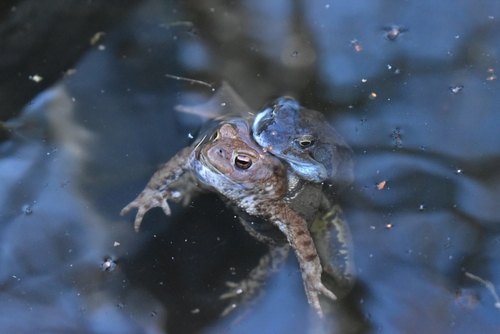
You’re going to confuse people. You’re describing tank mates for an African DWARF Frog, not an African CLAWED Frog. Even worse, you’ve posted a picture of an ACF.
You’re totally right to flag this, and we really appreciate it. African Clawed Frogs and African Dwarf Frogs often get lumped together, but they’re actually very different in temperament and tank needs. ACFs are much more aggressive and grow larger, which makes a big difference for tank mate compatibility. We’ll review the post to make sure it reflects that clearly, thanks again for helping us keep things accurate for fellow frog lovers! 🐸💚If you’ve kept either species, we’d love to hear what’s worked well (or not so well) in your tank. It helps the whole community learn!